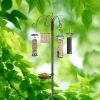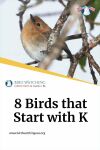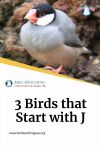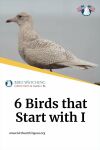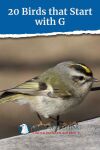
Introduction
Have you ever thought of birds that begin with the letter G? If yes, then you’re at the right place for sure. Even better if you’re curious about the most common birds in the USA and Canada that begin with G. I’m here to give you a quick answer: there are only 20 of those birds. Now at only 2.6%, that’s not really much, is it? But you must be wondering who these birds are.
So, I decided to compile it all in a list arranged in descending order. All credit goes to the information provided by our fellow birdwatchers at EBirds, which is an open platform for birdwatchers and bird lovers to contribute their findings to one big database.
Let’s get to see the names of these birds real quick.
| Great Blue Heron | 16.78% |
|---|---|
| Gray Catbird | 11.89% |
| Great Egret | 9.79% |
| Gadwall | 4.71% |
| Great Crested Flycatcher | 4.45% |
| Green-winged Teal | 3.98% |
| Green Heron | 3.76% |
| Golden-crowned Kinglet | 3.49% |
| Greater Yellowlegs | 3.39% |
| Great-tailed Grackle | 3.24% |
| Great Black-backed Gull | 2.94% |
| Golden-crowned Sparrow | 2.13% |
| Great Horned Owl | 1.70% |
| Glaucous-winged Gull | 1.23% |
| Greater Scaup | 1.13% |
| Gila Woodpecker | 1.02% |
| Glossy Ibis | 0.91% |
| Gambel’s Quail | 0.89% |
| Greater White-fronted Goose | 0.71% |
| Golden-fronted Woodpecker | 0.70% |
Eager to learn more? Then go ahead and come with me on a journey to learn more about these feathered friends. I’ve also included many details, along with birdwatching tips! And oh yes, #16 is my personal favorite so don’t forget to look at it!
1. Great Blue Heron
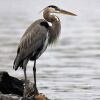
At number 1 on our list is the Great Blue Heron! You might have already seen these birds along a coastline or the edge of a river just like I did. You can see their light gray-grown bodies slowly moving, looking for animals. You can also find them standing still while foraging for fish, but they eat other reptiles as well. Perhaps you’ll find one feasting away on frogs, rodents, or even snakes! Their flexible neck allows them to attack their prey even from quite a distance.
So how about finding one of these birds visiting your home? Speaking from personal experience, the Great Blue Heron is not the kind of bird that you can find in your backyard. But if you have a fish pond, then you might just be in luck! Since my backyard is all greenery and no body of water, I had to head out to see this spectacular bird. I found plenty of them in marshes and along rivers. I was able to spot a few in open fields like farmlands and meadows as well.
If you’re lucky, you’ll be able to spot the White version of this bird too. It is known as the Great White Heron and their typical hangout place is in the shallow waters of the Caribbean, Florida, and the Yucatan Peninsula.
Since their squawks are so harsh, you cannot mistake the Herons for any other bird!
PRO-TIP
the weight of the great blue heron
You'll be surprised to know that although the Great Blue Heron looks quite bulky, it weighs very little. Thanks to their hollow bones, they weigh roughly around 5 to 6 pounds.
2. Gray Catbird
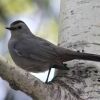
On # 2 we have the Gray Catbird, that, as you’ll see, is quite a multitalented fellow.
It’s quite fascinating to see them use their bills to rummage through leaves. They’re always on the lookout for berries and insects while foraging on the ground. So you can imagine how easy it is to attract a Gray Catbird to your backyard. In fact, I was able to find one thanks to the young deciduous trees I have in my yard, as well as berries growing in shrubs. Serviceberries, winterberries, and dogwoods really get these catbirds going!
Also, if you have a birdfeeder up in your backyard, you can fill it with diverse treats. Gray catbirds can eat anything from boiled potatoes and cornflakes to sweeter treats like doughnuts. In the winter, they are more likely to move towards the southern or tropical regions of the United States.
Oh and if you’re wondering - Why is this bird called a ‘catbird’ anyway? Well, it all comes down to their calls, which sound like a cat’s mew. And that’s not all, they’re even good at mimicking other birds.
did you know?
gray catbirds are quite the singers
The Gray Catbirds don't only go for short mews. They sing for a very long duration, and their songs can last as long as 10 minutes.
3. Great Egret
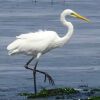
Up next on #3 is the Great Egret!
If you live in the South of the United States, you’ll be able to spot this white-feathered beauty rather easily. But, in the late summer, it heads toward the North.
In my younger years, I spotted my very first Great Egret in the quiet waters. It is very fond of foraging in shallow water, either by walking or or even simply standing. Since these birds mostly eat fish, it’s the ideal spot for them! Once the fish comes near, they use their bills in one swift movement to catch their prey. Quite the fishmongers, aren’t they?
But they’re also known to forage the grounds. In that case, their likely targets are insects like grasshoppers and other rodents as well. And even reptiles like snakes!
The Great Egret birds squawk very loudly when they’re in nesting colonies. Otherwise, you can hear a closed, cloaking sound.
fun fact
find them with the cattle
The Great Egret loves to forage around cattle too! So if you have a farm nearby with many cows, you might just be able to see one of these lovely birds, if not a flock.
4. Gadwall
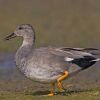
Here comes the Gadwall at #4!
The coolest place for Gadwalls to hang out is a body of water that also has vegetation. I came across a pair foraging while swimming. They don’t just put in their heads to capture food, but are smooth at diving in as well. Although they love eating small fish, they’re extremely fond of aquatic plants. In fact, they’re more likely to eat plants than any other species of ducks. And they’re quite good at stealing food from other ducks too, especially from the American Coots.
What’s another fact that I found interesting? They don’t forage on land much. So no, you can’t find this beauty randomly in your backyard. Even their nesting place is preferably close to bodies of water, but once I saw them building a nest on dry land surrounded by dense grass and weeds too! Although it’s the female that builds the nest, it’s the male bird that goes on flight mode to find a suitable spot.
Just like any other duck, the Gadwall also quacks, but you can hear it whistling and chattering as well.
fun fact
young gadwalls
The adult Gadwall mostly has a vegetarian diet. But it's not that way in the beginning! The young ones start off by eating insects before moving towards plants. They 're quite quick to leave the nest after hatching.
5. Great Crested Flycatcher
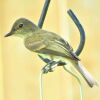
On #5 we have the Great Crested Flycatcher!
One of my best experiences has been attracting a pair of Great Crested Flycatcher to my backyard! It’s quite simple actually, because they are used to nesting in cavities. But trees can’t always have the type of hole that’s ideal for nesting. So my wife and I decided to put up a nest box to attract a cute birdie couple of this kind. Just remember to complete the setup before the breeding season begins!
When foraging, the Great Crested Flycatcher is most likely to catch insects mid-air. If you’re living in the tropics though, you may want to scatter tits and bits of fruit in your backyard. It makes up a major portion of their winter diet! It’s also awesome to watch them swallow the fruits whole.
But what about if you’re planning a trip to the woods? It would be easier for you to detect this birds’ call rather than see it. Keep your ears open to the sound of repetitive ‘whit-whit-whit’.
fun fact
courting among the great crested flycatchers
Did you know that in courting, the male bird chases the female among the trees? Try witnessing it live if you're heading to the woods!
6. Green-winged Teal
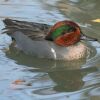
Here comes the stunning Green-winged Teal at #6!
The most ideal places to look for the Green-winged teal are bays, rivers, marshes, and other bodies of water. They swim or wade to forage and on the lookout for food both during the day and night. You can even find them on the coast as I did some time back during winter. Since their diet is mostly made of plants, your best bet is to look for these birds where there’s shallow water but plenty of vegetation!
But they can also eat animals and other insects too. These may include mosquitoes and even fish eggs. But all that is more likely during the summer, as seeds are their most favorite in the winter season.
Also, you can hear them clearly whistling again and again in a loop. But that’s just the males, the females quack in the typical manner that ducks do!
In Alaska, you can find one-of-a-kind race of Green-winged Teal birds that you won’t come across anywhere else. Since these birds don’t migrate, you’ll have plan a visit to the Aleutian Islands to actually see them! Their migration takes place within the various spots of the island itself. So during the summer you can find them at ponds on the island, whereas in the winter, they move toward the beaches!
fun fact
the green-winged teal courtship
As courtship display, the male usually makes moves with its head, while being in water. It shakes the bill very quickly and moves in and out of the water whilst whistling.
7. Green Heron
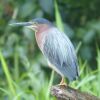
Dear birdwatcher, do you have a fish pond in your backyard? If yes, that’s good news for you and fellow Green Heron birds. They are at # 7 on our list of common birds that start with G. And guess what? They absolutely love visiting bodies of water. I have experienced it first-hand when I went to stay at a relative’s house. They have a huge fish pond in their backyard and watching a Green Heron come over was a delightful sight! But of course, protecting the fish is key, so you can use a drain pipe or any other covering for that.
These birds love to forage by waiting for their prey to come to them. So while they’re being patient, they’re either standing still or stalking a bit in the shallow water to create a movement. Another surprising fact is that they even use bait to lure in their meal. So you can expect a Green Heron to use a feather or or even a small stick to attract fish.
They even eat rodents like mice or other insects such as grasshoppers, snails, and even earthworms.
pro-tip
Look out for their call
You may find these birds difficult to spot if you're going out in the wild. Their hunched backs are key, but you can also detect their sound which is a 'skeow'. When in flight, they unfold their necks which can make it easier for you to recognize them!
8. Golden-crowned Kinglet
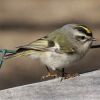
This Golden-crowned Kinglet is on #8. And it’s also one of my favorites, thanks to the pop of its black and yellow feathers! I saw this bird for the first time in the summer, in dense spruce. Since they’re do tiny, its really hard to spot them. So I still consider it a lucky shot because in nature, you can only find these birds hiding away in the dense texture of forest trees.
Although these birds are teeny tiny, they can endure temperatures as low as -40 Fahrenheit! So if you’re heading to the woods in the winter, you can use their sound as a tool to search them! Their voice is thin and their song goes like ti-ti-ti, along with some chattering to follow. These high calls are very common while they’re foraging.
fun fact
nostrils of the golden-crowned kinglet
Each of their nostrils is covered by an extremely small and tiny feather. Although it's barely visible, it protects these birds against harsh and cold weather.
9. Greater Yellowlegs
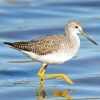
Look who we have on #9 - the Greater Yellowlegs!
Your best bet to find these beauties is in the Spring and during their Fall migration. Since it’s a shorebird, it loves to stay around places where there’s plenty of water. I was able to spot a Greater Yellowlegs bird in a shallow marsh once. And it was in a drought-like environment, with plenty of rich mud for them to enjoy.
And it makes sense too, since these birds love to forage in shallow water! The one I saw was dipping its bill in the water to catch any fish it can come across. But since luck wasn’t on its side, it started looking for insects instead. I saw it quickly picking up a snail in its bill and eat it whole. That was just my experience though. These birds have a diverse diet that includes other insects like marine worms, or even reptiles such as tadpoles. Sometimes, they step out of this pattern by eating berries too!
Oh, and you can even use their sound to look out for them. Especially while courting, you’re more likely to hear the ‘whew-whew-whew’ call by the male bird. It’s also accompanied by whistles and a magnificent fluttering flight display!
fun fact
they are called 'marshpipers'
'Marshpiper' is another name for the Greater Yellowlegs. And it suits them well too, because these birds tend to go deeper into water, compared to the rest of the sandpipers.
10. Great-tailed Grackle
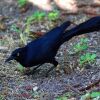
Ah, the Great-tailed Grackle! This blackbird is on #10 of this list and for all the right reasons.
It can be quite easy to invite the Great-tailed Grackle to your outdoor space. I can vouch for that fact, because it came over to my backyard as well. If you have a birdfeeder, simply take some seeds and spread them around. You don’t have to go for exclusive bird feed either. I used cracked corn, and it worked like a charm!
You may also be able to spot them in a park in the city. These birds can adjust themselves to a variety of habitats! When they’re foraging on open areas such as lawns and pastures, you can even witness flocks of them. And when in water, you’ll find them wading to catch small fish. They’re clearly omnivorous as they also attack the nests of other birds.
Feeling confused? Well here’s another tip: It’s their long legs that make them stand out and easy to recognize, compared to other fellow blackbirds. Also, their sound is a fusion of whistling, hissing, and clucking.
fun fact
greater number of females
Did you know that the female Great-tailed Grackles are smaller in size? And due to their body mass, they require lesser food. They're more likely to survive than their male counterparts and thus, you'll see there are more females than males.
11. Great Black-backed Gull
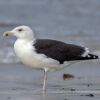
Next up we have the Great Black-backed Gull, which is #11 and also one of my personal favorites. Since it’s a gull, beaches and fishing piers are a good place to go look for it. You can expect them in huge flocks along the Eastern coasts of North America.
I was able to spot this bird instantly thanks to its huge body size, broad wings, and prominent black back. What I further found fascinating was its omnivorous diet. These birds can eat anything from marine worms, rodents, insects and the eggs of other birds to even berries. Its deep ‘keoww’ sound also attracted my attention, which is deeper compared to that of the Herring Gull!
Another amazing fact is that they even hunt down large birds. Puffins and grebes are often among the adult birds they are likely to prey upon!
fun fact
the largest gull
That's right. It's called the 'Great' Black-backed gull because it's the largest bird among gulls. Since it's also the strongest, no other gull dares to invade or threaten it.
12. Golden-crowned Sparrow
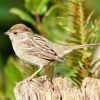
On #12, we have the gorgeous Golden-crowned sparrow! Just like the common sparrows, you can literally find them anywhere. They love to dwell among low shrubs but they also have quite a liking for city life. The edges of the Pacific Coast are a good place to check in on these beauties, right where the cities begin.
It’s called Golden-crowned for a reason. The beautiful pop of golden-yellow on its head makes this bird stand out among other sparrows. And that is what made it easy for me to recognize it as it visited me in the backyard once! Simply have the birdfeeder ready with pieces of fruits. And if that’s not possible, these sparrows eat from the ground as well - if you have plenty of buds and flowers for them to choose from! But if you have vegetables, remember that they can end up spoiling them, so establish a birdfeeding system wisely!
Here’s a bird-feeder I highly recommend.
North States Bird 1862 Ultimate Station Birdfeeder, Black
It comes with a 1-7 ft pole, along with 4 hooks and multiple tube feeders to put in various types of feed for various birds.
fun fact
song pattern unknown
Does the song of the golden-crowned sparrow have any patterns? Nobody can say for sure, although there has been scientific study into it. All we can listen are notes that sound scattered and have also been called 'mournful' and 'depressing' by some!
13. Great Horned Owl
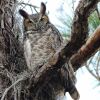
We have a stunning owl on #13! The Great Horned Owl is one of those species you can find in almost all of North and South America.
Since owls love to build their nest in tree cavities, they’re attracted to nest boxes as well! I set up a nest box once in my backyard and was surprised to find a breeding pair of these magnificent creatures. Why not try it yourself? But remember to put up a guard over it so no predator can reach for the owl’s eggs or young ones. And remember that they are owls so their most active hunting time is at night! If your outdoor space has rodents, they better watch out!
You’ll also be able to observe the differences in male and female voices. The male owl has a deeper voice, thanks to a larger voice box. I found the pair in my backyard calling together in hoots of different pitches and it was absolutely beautiful!
fun fact
vicious predators
Did you know that the Great-Horned owl can attack large predatory birds? They've been known to take down and eat falcons and ospreys. They can even eat many other owls!
14. Glaucous-winged Gull
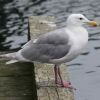
Here comes the Glaucous-winged Gull at #14, with their subtle yet beautiful white-and-grey feathered bodies!
These are the gulls you’re going to find all year around along the coasts of Alaska, Washington and in-between! I came across a few during the Winter while I was having a vacation in the South. I found them along the coasts as they rarely come move inward toward the land, even if it’s cold.
So how do they forage? Well, since they’re omnivorous, you’ll find them hunting for food while in the water and even outside of it. So either they’re walking while foraging, or they’re swimming. They mostly eat fish, squids, crabs, and other marine life. But they can even hunt down smaller birds and animals, along with several plants. Their diet is quite diverse and I even found one of them making good use of scraps from a garbage dump!
These birds have two calls, where one has a generic gull voice. And the other is more like it’s whining!
fun fact
Gulls are hybrid species
Gulls have the tendency to mate with various species within their family. For instance, a Western gull can hybridize with the Glaucous-winged gull, and so on. the hybrid of those two is known as the 'Olympic Gull'. The hybrid species are so much on the rise that they may even surpass their parents!
15. Greater Scaup
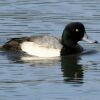
Up next at #15 is the Greater Scaup! To find this dark-green headed beauty, you’ll definitely have to plan a trip to the coastlines.
I was able to see these ducks diving into the Great Lakes during the migration season. These are the months between February and April, and October and November. But you can also find them during the Winter on water near coasts. But it’s best if you keep a spotting scope with you, as they sit quite far away from the shore. Moreover, similar birds might be in the area and you may end up feeling confused.
They forage diving deep underwater or even via swimming. I’ve seen the Greater Scaup eating a variety of creatures, such as oysters and clams, which makes up most of their winter diet. When it’s summer though, they’ll switch to eating plants such as grasses, celeries, and pondweeds!
The fun part is that these birds are silent most of the time. But when they’re breeding, you can expect to hear them croak a bit.
Here’s a spotting scope that I recommend you take along with you to the coastlines.
Celestron 52238 C70 Mini Mak Spotting Scope, 25-75x
This spotting scope has a tabletop tripod that will allow you to setup wherever you want!
fun fact
the oldest greater scaup
The oldest recorded age of a (male) Greater Scaup was 20 years and 5 months in Michigan, 2007.
16. Gila Woodpecker
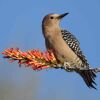
Make way for the Gila Woodpecker on #16 in this list!
These little creatures are quite the noisy lot. And with deserts being their natural habitat, that’s the best place to go look for them. I spotted these in the South West of the United States once, they’re just fond of treeless environments! I could also see one making a hole in a live Saguaro Cactus. The fun part is that these woodpeckers wait till the inner cavity becomes solid before making use of the hole as a place for living.
Once you’re in the desert, you can easily see these tiny feathered friends foraging cactus fruit, berries, and even insects. But wait- there’s more. You can actually invite these little fellows to your backyard! All you have to do install feeding stations of various types, these could be platforms, tubes, and even bird feeders. Fill them up with various nuts and fruits; corns and pecans are a good choice too!
fun fact
their nests are reused
After the young ones of the Gila Woodpecker leave, the nest is useless to them. So other birds come and take over the nest. These include pygmy owls, elf owls, and even flycatchers.
17. Glossy Ibis
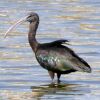
On #17 we have the stunning Glossy Ibis! You can see that it looks quite dark. But I can tell you to look closely and you’ll be surprised. They have specks of other colors in their feathers, namely bronze, violet, emerald, and deep maroon. These birds love to spread out geographically, so you can find them in the East of North America, and even in the South-East of the United States.
These birds love to forage muddy areas. So guess what? You can find flocks of them in marshes or near other bodies of water. They prefer food-hunting in groups rather than scavenging on their own. Their diet is mostly made up of small fish, seeds, and plenty of insects!
fun fact
glossy ibises in other continents
You can find these birds in Asia, Africa, and Europe too!
18. Gambel’s Quail
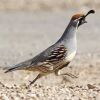
Next up on #18 is the Gambel’s Quail!
These birds love to forage in green vegetation. So you can expect to see them in masses when there’s been plenty of rainfall during the seasons of winter and spring. In such conditions, they are more likely to multiply fast and you can get to see many chicks!
Although Gambel’s Quails wander around on the desert ground, they can visit your backyard too! You can put bowls of water and birdseed on the ground. Even if you place them at a high level, the Gambel’s Quail will be able to reach out to it somehow.
The best time to look for these birds is early in the morning or when it’s late noon. These are their most active times, and you can easily find them in shrubs or near plants that have thorns! Just don’t get too close as flocks of them might be hiding and you can scare them all to go into flight mode.
fun fact
gambel's quail in hawaii
Did you know that the Gambel's Quail has been sighted in Hawaii too? Birdwatchers were able to see the bird near and around the Mauna Kea volcano.
Find it tricky to spot birds in bushes? Make your birdwatching easier by getting yourself this pair of binoculars .
Athlon Optics Midas Binoculars for Adults and Kids
These binoculars are the best pick because they're durable and waterproof! It has ED glass which means the images will be clear and crisp.
19. Greater White-fronted Goose
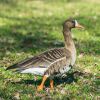
Now on #19 we have the Greater White-fronted Goose! You can clearly see the white patch it has above its beak, doesn’t it look elegant?
These geese are most likely to feed themselves straight from the ground. So you can find them foraging by walking, but they even submerge themselves into water to pick out aquatic insects. Their diet is mostly made up of plants, along with a few buds, berries, and seeds. They even eat snails sometimes, though that’s mostly along with plants and not separately!
Go look for this goose in North America, namely towards the Western bank of the Mississippi River! You will able to find flocks of them leaving before sunrise during the winter. You can also look for them in Louisiana, California, and Texas in the winter season. However, for nesting, they prefer Southern Alaska!
fun fact
the oldest greater white-fronted goose
The oldest recorded age for this bird is 25 years, 6 months.
20. Golden-fronted Woodpecker
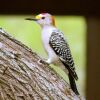
Last but not least, we have the Golden-fronted Woodpecker on #20! You can find these birds in abundance in northern Central America and eastern Mexico! Within these regions, you can easily find these woodpeckers in the woods!
When I first came across this woodpecker, it was looking for food on tree trunks. It was also walking on the limbs and branches to pick out fruits, berries, or nuts. But that’s not all, these woodpeckers are omnivorous and wouldn’t hesitate a bit before eating insects too. Although their personal favorite of all are acorns!
You can also pay attention to its chuck-chuck-chuck like calls!
fun fact
interbreeding
The Golden-fronted woodpecker is very similar to the Red-bellied Woodpecker. They look pretty much the same, and they often interbreed too! But when they don't, they defend their territories from one another.
Conclusion
So those are the 20 most common birds that start with G! Which one made it to your list of favorites? Have you seen them all? Even if you haven’t, I hope all the birdwatching tips will help you check each bird off the list. And if you want to learn more about the most common birds, here’s a post of the birds that start with the letter H .
31 Birds that Start with H
Did you know that 31 of the 750 most common birds in the USA and Canada begin with the letter H? Here's the complete list along with beautiful pictures!

By David A. Swanson
Bird Watching USA
My name is David and I'm the the founder of Bird Watching USA! I started Bird Watching with My father-in-law many years ago, and I've become an addict to watching these beautiful creatures. I've learnt so much over about bird watching over the years that I want to share with the world everything I know about them!

David A. Swanson
Bird Watching USA
My name is David and I'm the the founder of Bird Watching USA! I started Bird Watching with My father-in-law many years ago, and I've become an addict to watching these beautiful creatures. I've learnt so much over about bird watching over the years that I want to share with the world everything I know about them!

